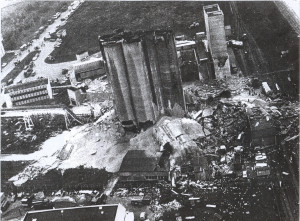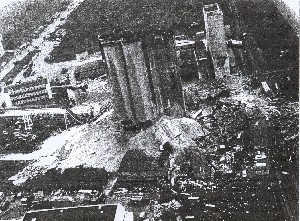An explosion occurred at 2:15 pm inside the materials handling tower of a silo located at a malt house during repairs of the facility’s slabs and installation of a dust removal system, performed by 3 subcontracted employees. The filling ratio of silo cells was set at 12,000 tonnes compared with a theoretical capacity of 15,000 tonnes. A second more powerful explosion was felt a few seconds later, causing the tower to collapse along with 8 of the 14 cells containing barley and malt. Flames could be seen at various spots inside the silo boundary. 12 workers, including malt house personnel, subcontractor employees and lorry drivers (perhaps clients) were killed and buried under the rubble and debris. Three others sustained injuries, one of whom was in serious condition. Considerable rescue efforts were deployed in the hope of finding survivors (a response team of 600 in all were dispatched to the site, including canine units and two cranes able to lift 150 and 300 tonnes, respectively). The instability of residual structures plus the tremendous pile of concrete rubble and spare equipment covered by grain strewn by the explosions severely complicated this rescue effort; the last victim was not removed from under the debris until 5 days later. Grain combustion raged another several days over the upper part of the cells that had not collapsed. Property damage, confined to the silo and its immediate surroundings over a distance approximately equal to the height of the installations, was assessed at 70 million francs (1982 currency value). The barley and malt debris disposed at the dumpsite of a former gravel pit wound up polluting the MOSELLE River alluvial fan for 2 years within a water extraction zone.
The cause and exact sequence of the explosions could not be precisely determined. The most likely hypothesis is that an initial explosion in the tower generated by the combination of an ignition source introduced during the works (or a careless smoker) and an explosive atmosphere caused dust to scatter inside the facility, leading to a second explosion throughout the tower and extending into the upper gallery and spaces between cells, where the collapses were eventually observed (outer row cells of the handling tower). The investigation also indicated the site’s major dust accumulation problem, along with inadequate technical equipment (a complex dust removal system lacking efficiency features, absence of vents, etc.), organisational deficiencies (no practice of circulating memoranda relative to installation safety, no written instructions for carrying out works, no hot work permitting procedure) and, lastly, the workforce’s general underestimation of the fire and explosion risks.
Download the detailed report in .pdf format (174 Kb)





